|
|
Advertisement:
|
|
Antec SmartPower 2 350W PSU |
|
Join the community - in the OCAU Forums!
|
Today I'm reviewing the Antec Smartpower 2.0 350w. This is Antec’s cheapest ATX V2.0 PSU and cost me $105, bundled with the Antec SLK1650b case. Typically the PSU on its own retails for $65 in most online stores.
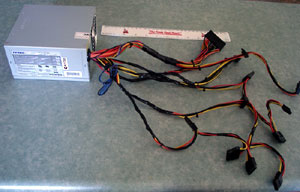
At a first glance, it’s fairly obvious this is a no-frills PSU. No LED fans or sleek black paint, however it still looks fine and neat, especially in the 1650b case. Connector wise the PSU is slightly disappointing, but the big plus is it comes with a PCIE power connector. So, no need to use any clunky adapters to power modern video cards. The PSU comes with an impressive 4 SATA connectors, great for newer systems. Unfortunately from here it’s not so grand. The PSU includes 5 molex connectors, plenty if you’ve got SATA hard drives, but if you’ve still got a RAID array of IDE drives, and you’ll need a few molex splitters. Finally there’s the usual one floppy connector, 4pin ATX12V, 24pin ATX and fan monitor cables. The other main problem is that the cables are rather short. The 4pin ATX12V and 24pin (4pins are detachable for compatibility with 20pin motherboards) are about right length for standard ATX case, but will be too short for say a Antec P180 case or others where the PSU is on the bottom of the case. The PCIE power connector is the most curious - surely they could have made it a bit longer without adding much cost to the unit, as even in my case there is little slack, so no slick cable routing is possible. Finally none of the cables are sleeved, or even twisted, so it can get a little messy inside your case unless you tie them back. I didn’t have time or bother to sleeve them myself, so some black tape took care of that problem - the 1650b case has no window, so no problems of aesthetics. Again nothing serious, but as a comparison, the cheaper Silverstone ST-365 has none of these drawbacks, except for the lack of a PCIE power connector.
Specifications and Test System:
Antec’s specifications are just slightly ambiguous, unfortunately. While the individual 12V rail specifications are given as 10A (12V1) and 15A (12V2), no combined rating is given. Though it’s most likely that is 25A, which is excellent. There are power supplies (usually generic brands) of over 500W that have smaller combined 12V ratings (and often not even a 24pin ATX connector). And since that for Athlon64/P4, 80% or more of the load is on this rail, it makes it a big factor in making a quality PSU (more important than wattage ratings actually). The voltage regulation is rated to the standard +-5% as per ATX spec.
To test a PSU a properly you need to give it the ‘worst case scenario’ (something many PSU reviewers fail to consider when they test their SLI capable PSU’s on often fairly light single video card systems). I doubt anyone would try and run a high end SLI system off this PSU, except perhaps a 6600gt SLI system, which we can assume this PSU would handle fine if it copes with our test system. So, our worst case scenario is a heavily overclocked single video card system with lots of hard drives / peripherals. The specifications are:- AMD Opteron 146 @ 2.9ghz (1.51V)
- ATI X800XT @ 560/525 (flashed from X800PRO)
- OCZ value VX @ 2-2-2-6 242mhz 3.3V (bh-5)
- DFI ultra-D motherboard
- 2 160gb hard drives (1 IDE, 1 SATA)
- 2 optical drives
- 5 LED case fans
- Cold cathode lighting
- DVB card + sound card
Not satisfied that this system was putting a big enough load on the PSU (particularly in regard to the new x1900xt/7800gtx 512mb cards that draw roughly an extra 40w or so on top of my graphics card - off the 12V rail), I made up a couple of resistor banks (a total of 12 33ohm 5W resistors), to add roughly another 4.5A on the 12V rail or 55w (could also represent a dual core P4 heavily overclocked, or another 6 or so hard drives). With everything plugged in, the system booted to Windows without a hitch.
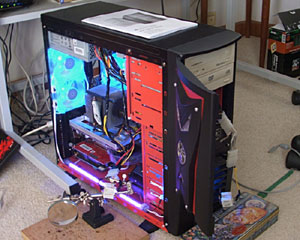
Testing:
Our somewhat power-hungry test system should be a good test of whether the PSU can live to its specifications. First up on the list was a few runs of 3DMark05, which went fine, scoring the usual 6600 marks or so I got with the Tagan PSU that normally runs this system. While testing 3DMark05, I measured the rails with a $17 Digitor multimeter, which is rated for within 0.5% accuracy.
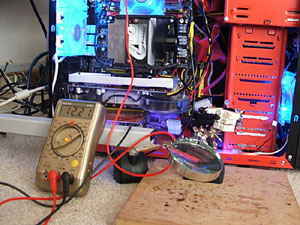
The 5V and 12V rails were measured off a molex connector, and the 3.3V off the main 24pin ATX connector. The results were:
Idle voltages:
3.3V: 3.33V
5V: 5.02V
12V: 12.4V
Load (3dmark05) voltages:
3.3V: 3.32V
5V: 5.05V
12V: 12.32V
Extreme Load (resistor banks plugged in while running 3dmark05) voltages:
3.3V: 3.32V
5V: 5.07V
12V: 12.22V
These are fairly impressive results for a budget unit, though the 12V rail is slightly high when lightly loaded. To quantify this, the 3.3V and 5V rails within 1% from nominal (well within ATX spec), barely moved at all. The 12V rail starts off about 3.4% from nominal at idle, and would be even higher for a very light system (eg sempron/6200). Once the PSU is loaded up the 12V rail improves, to an excellent 12.22V when heavily loaded (2% from nominal). Also as expected the two 12V rails both came from the same source (voltage regulator/transformer tap), as indicated by a resistance of 0.03ohms (a short - same result as measuring from molex-molex) between 12V2 (4pin atx12V), and 12V1 (molex connector). Since I wanted to keep the warranty, I didn’t open the unit up to check for separate 20A current limiters, but at this level it doesn’t matter from a users point of view (since the combined 12V rating of 25A would be exceeded before 20A is drawn off either individual 12V rail). Also the heavy load of video card + hard drives + fans + load resisters should have easily exceeded 10A draw on 12V1, so current limiters would very likely be set to 20A and not as specified (which would make more sense since 20A current limiters are there for UL/EN60950 safety regulations, so no point setting them any lower than the required 240W/20A).
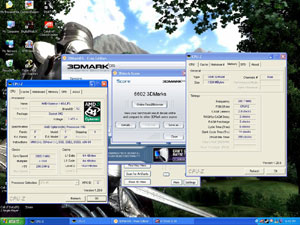
It should be noted, however, that 3dmark05 isn’t that sensitive to errors (as OCAU found out in their 13 PSU roundup a while back), so to continue testing the PSU’s voltage stability I did a few 32mb SuperPi runs, and it passed every time. Also I played some Counter Strike: Source for a few hours, as well as Colin McRae Rally 05 and Battlefield 2, with no signs of instability - all while having the load resistors connected.
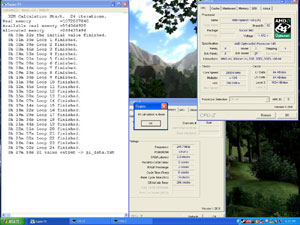
In terms of noise the PSU is very quiet, due to the smart push-pull 80mm fan design and well designed airflow. At low loads (PC idling without load resistors connected) the rear exhaust fan doesn’t even spin, so the PSU is practically inaudible since the intake fan is inside the case. The exhaust fan spins up once games have been running for a few minutes. At higher loads the PSU is slightly noticeable, though again this only occurs when games are running. Even then, the majority of users will find that other fans in the system will be louder, especially if the fans are running at full voltage.
Conclusion:
Despite what you might expect, it seems that the small wattage rating (in comparison to the rest of the Antec range) doesn’t restrict this PSU to only low-end systems. This backs up the results from the earlier PSU roundup where the predecessor to this unit fared well against higher-rated competitors. Even with the additional 4.5A provided by the load resistors on the 12V rail, the PSU handled our test system well, without a hint of instability. The fact there wasn’t a single system crash, or even a game crash during the week of use indicates this is a strong PSU that should handle pretty much any single video card desktop system you try it in.
Pros:- Excellent stability, enough to handle just about any single video card system, even heavily overclocked.
- PCIE power connector included and 4 SATA connectors.
- Quiet especially at low loads.
Cons:- Some short cables, and no sleeving or twisting of cables
- 12V rail set a little high, so may not be the best choice for very light systems.
- ‘Only’ 5 molex connectors.
Note: DFI has a 480w minimum PSU policy for their ‘Lanparty’ series boards, so I wouldn’t recommend using this PSU for the ultra-d/sli-d/expert/rd480 boards if you ever want tech support (despite the obvious capabilities of the PSU to run stable on these motherboards as this review proves).
Antec products are distributed in Australia by Altech Computers and available at many retailers around the country.
|
|
Advertisement:
All original content copyright James Rolfe.
All rights reserved. No reproduction allowed without written permission.
Interested in advertising on OCAU? Contact us for info.
|

|


